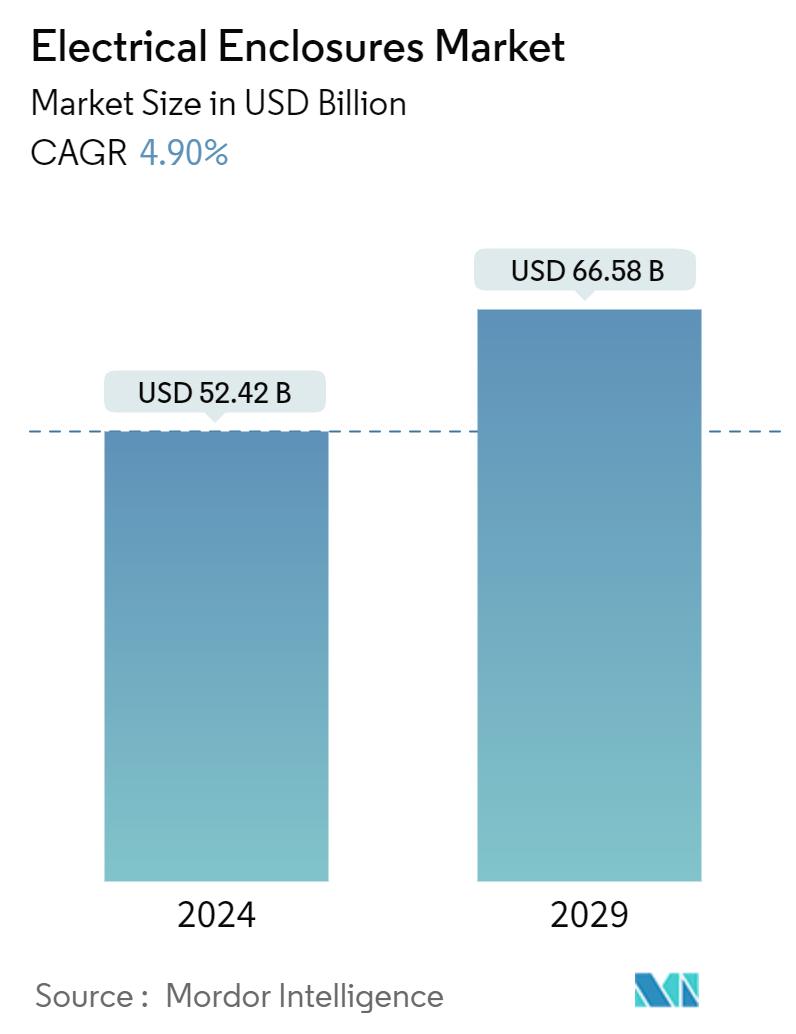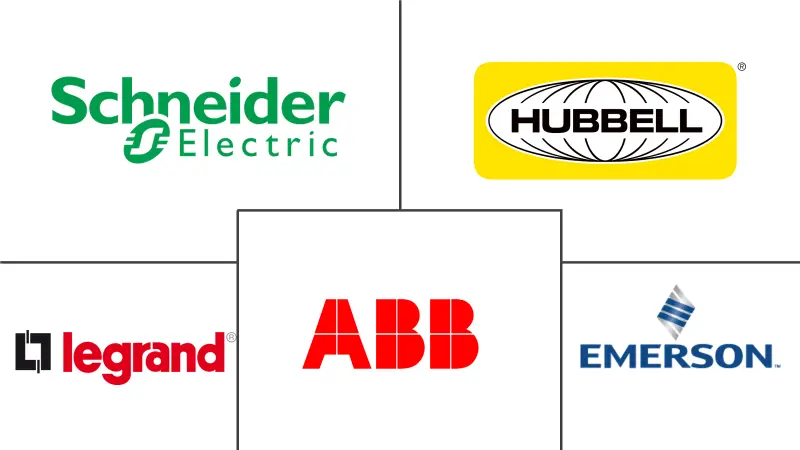Market Size of Electrical Enclosures Industry

| Study Period | 2019 - 2029 |
| Market Size (2024) | USD 52.42 Billion |
| Market Size (2029) | USD 66.58 Billion |
| CAGR (2024 - 2029) | 4.90 % |
| Fastest Growing Market | North America |
| Largest Market | Asia Pacific |
Major Players
*Disclaimer: Major Players sorted in no particular order |
Electrical Enclosures Market Analysis
The Electrical Enclosures Market size is estimated at USD 52.42 billion in 2024, and is expected to reach USD 66.58 billion by 2029, growing at a CAGR of 4.90% during the forecast period (2024-2029).
Owing to the increasing power and industrial infrastructure, the need for protection of the workplace and workforce is also increasing, which has led to the adoption of safety standards for the equipment in the industries. It has made electrical enclosures a crucial element in industrial and residential applications.
- Global energy consumption continues to grow significantly, as electricity demand is increasing as the trend for an ever-connected world accelerates. According to BP, Iceland has the largest per capita electricity consumption worldwide, averaging 52.98 megawatt-hours per person in 2021. It is due to the presence of energy-intensive industries in the country. Such instances are further driving the demand for electrical enclosures.
- Power generated from solar and wind sources uses sensitive electrical components and batteries that, if exposed to the elements, cause a system failure. Therefore, the energy generation sector uses electrical enclosures significantly for safety purposes.
- The acceptance of industrial and factory automation allows the entry of more mechanical, electromechanical, and solid-state devices, components, and controls that need to be enclosed for safety and aesthetic purposes, thereby driving the market growth. As a result, many countries have implemented stringent safety regulations globally, and this parameter is significantly driving the growth of the electrical enclosures market.
- For instance, the Construction Safety Alliance of Maine, SafetyWorks, and the Workplace Safety and Health Division of the Maine Department of Labor joined forces in August 2022 to promote workplace safety and health and inform construction employers and workers in the state about safety and health risks.The alliance will safeguard workers by lowering and minimizing exposure to construction-related risks like falls, injuries from being struck by objects, electrocution, and getting entangled in or between machinery and vehicles.
- The market is witnessing various developments as fabricators, and tier suppliers continue to develop composite solutions for protective battery enclosures. For instance, in March 2022, Mexico-based automotive tier 1 Katcon developed a multi-material toolbox for cost-effective, scalable EV battery enclosure design.
- The Coronavirus pandemic complicated the situation of the adoption of electrical enclosures in various sectors. It has changed the standard operating procedure by bringing in unique challenges of social distancing and contactless operation. Organizations were forced to limit their workforce and deal with the increasing demand. With the shutdown of several industries, the market witnessed a negative impact. Although, with the ease of restrictions and the opening of industries at full capacity, the market has started to gain traction.
Electrical Enclosures Industry Segmentation
An electrical enclosure is a cabinet for electrical or electronic equipment to mount switches, knobs, and displays to prevent electrical shock to equipment users and protect the contents from the environment. Electrical enclosures are made of two types of material, metallic and non-metallic. The electrical enclosures are used in energy, power, industrial, process, transportation, infrastructure, and telecommunication industries.
The electronic enclosure market is segmented by material (metallic, non-metallic), by end-user industry (energy and power, industrial [automotive and manufacturing], process industries, other end-user industries [transportation, infrastructure, and telecommunication], by Geography (North America [[United States, Canada], Europe [United Kingdom, Germany, Rest of Europe], Asia Pacific [China, India, Japan, and Rest of Asia Pacific], Latin America, Middle East and Africa). The report offers market forecasts and size in value (USD) for all the above segments.
| By Material | |
| Metallic | |
| Non-metallic |
| By End-user Industry | |
| Energy and Power | |
| Industrial (Automotive and Manufacturing) | |
| Process Industries | |
| Other End-user Industries (Transportation, Infrastructure, and Telecommunication) |
| By Geography*** | |||||
| |||||
| |||||
| |||||
| Australia and New Zealand | |||||
| Latin America | |||||
| Middle East and Africa |
Electrical Enclosures Market Size Summary
The electrical enclosures market is poised for significant growth, driven by the increasing demand for safety and protection in both industrial and residential applications. As global energy consumption rises, fueled by the trend towards an interconnected world, the need for robust electrical enclosures becomes paramount. These enclosures are essential for safeguarding sensitive electrical components in energy generation sectors, particularly in solar and wind energy, where exposure to elements can lead to system failures. The adoption of industrial automation and smart home technologies further propels the market, with regions like North America leading the charge due to their early adoption of these advancements. Stringent safety regulations and the push for renewable energy sources are also key factors contributing to the market's expansion.
The market landscape is moderately fragmented, with major players like ABB Ltd, Emerson Electric, and Schneider Electric SE actively engaging in product innovations and strategic partnerships to enhance their offerings and expand their global presence. Recent developments include the introduction of new enclosure series and the expansion of battery enclosure operations to support electric vehicle production. These initiatives reflect a broader industry trend towards sustainability and efficiency, aligning with regulatory support for renewable energy and energy-efficient technologies. As the market continues to evolve, opportunities abound in regions experiencing increased energy consumption and industrial automation, promising a dynamic future for electrical enclosures.
Electrical Enclosures Market Size - Table of Contents
-
1. MARKET INSIGHTS
-
1.1 Market Overview
-
1.2 Industry Attractiveness - Porter Five Forces Analysis
-
1.2.1 Threat of New Entrants
-
1.2.2 Bargaining Power of Buyers
-
1.2.3 Bargaining Power of Suppliers
-
1.2.4 Threat of Substitute Products
-
1.2.5 Intensity of Competitive Rivalry
-
-
1.3 Industry Value Chain Analysis
-
1.4 Assessment of Impact of COVID-19 on the market
-
-
2. MARKET SEGMENTATION
-
2.1 By Material
-
2.1.1 Metallic
-
2.1.2 Non-metallic
-
-
2.2 By End-user Industry
-
2.2.1 Energy and Power
-
2.2.2 Industrial (Automotive and Manufacturing)
-
2.2.3 Process Industries
-
2.2.4 Other End-user Industries (Transportation, Infrastructure, and Telecommunication)
-
-
2.3 By Geography***
-
2.3.1 North America
-
2.3.1.1 United States
-
2.3.1.2 Canada
-
-
2.3.2 Europe
-
2.3.2.1 United Kingdom
-
2.3.2.2 Germany
-
-
2.3.3 Asia
-
2.3.3.1 China
-
2.3.3.2 India
-
2.3.3.3 Japan
-
-
2.3.4 Australia and New Zealand
-
2.3.5 Latin America
-
2.3.6 Middle East and Africa
-
-
Electrical Enclosures Market Size FAQs
How big is the Electrical Enclosures Market?
The Electrical Enclosures Market size is expected to reach USD 52.42 billion in 2024 and grow at a CAGR of 4.90% to reach USD 66.58 billion by 2029.
What is the current Electrical Enclosures Market size?
In 2024, the Electrical Enclosures Market size is expected to reach USD 52.42 billion.

